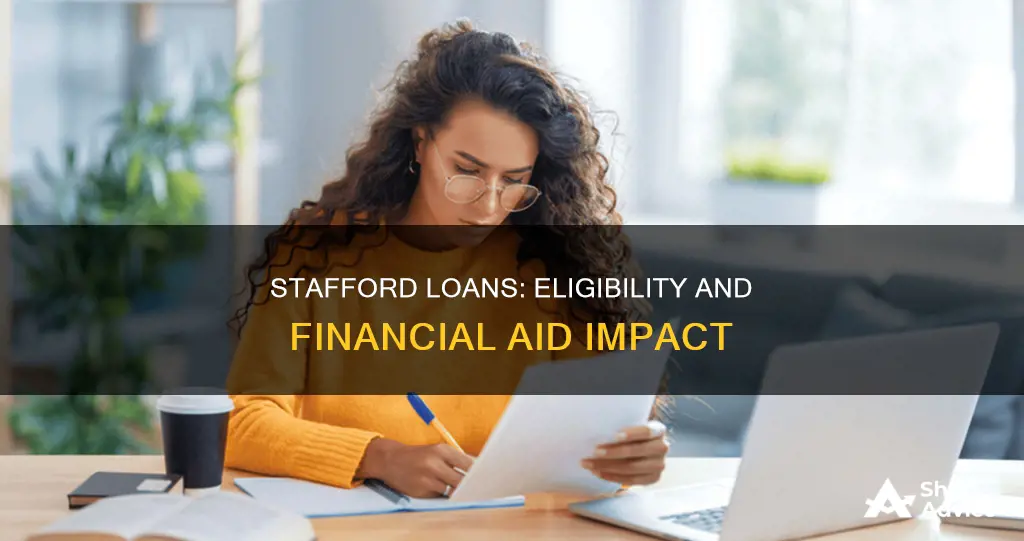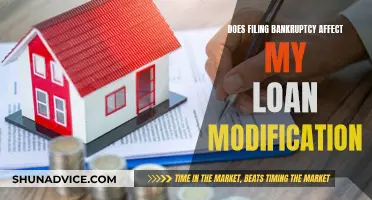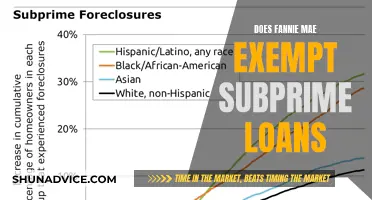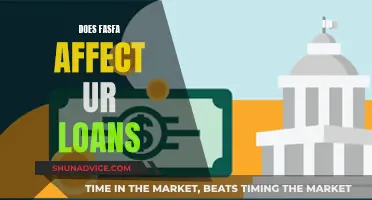
Federal Direct Stafford Loans are available to US citizens and permanent residents enrolled at least half-time in a degree program. Students who demonstrate financial need as determined by the FAFSA may borrow a subsidized Stafford Loan, while those who do not qualify may borrow an unsubsidized loan. The loan amount is determined by the school based on the cost of attendance and other financial aid received by the student. The total loan amount a student may borrow in subsidized and unsubsidized Stafford loans cannot exceed the annual loan limits or aggregate limits.
| Characteristics | Values |
|---|---|
| Types of Stafford Loans | Subsidized and Unsubsidized |
| Who can borrow? | Students who demonstrate financial need as determined by the FAFSA |
| Interest | Subsidized: Interest may be deferred and capitalized. Unsubsidized: Interest is assessed on the loan from the time the loan funds are disbursed |
| Interest Rate for Academic Year 2024-25 | Subsidized and Unsubsidized (Undergraduate): 6.53%. Unsubsidized (Graduate): 8.08% |
| Origination Fee | 1.057% for loans where the first disbursement is made on or after October 1, 2020, and before October 1, 2025 |
| Repayment Period | Up to 10 years with no penalty for early repayment |
| Application Process | Complete an online entrance interview and a Master Promissory Note (MPN) at www.studentaid.gov |
| Financial Aid Eligibility | Financial aid eligibility may be affected if a student receives disbursements from another institution within the same academic year |
What You'll Learn

Subsidized vs. unsubsidized Stafford loans
Subsidized and unsubsidized Stafford loans are federal student loans offered by the US Department of Education. They require borrowers to be enrolled in school at least half-time to be eligible and offer a six-month grace period before repayment starts. The main difference between the two types of loans is how they handle interest.
With subsidized Stafford loans, the government pays the interest while the student is enrolled in school at least half-time, as well as during the six-month grace period after graduation or after the borrower is no longer enrolled half-time. These loans are available to undergraduate students who demonstrate financial need as determined by the Free Application for Federal Student Aid (FAFSA).
On the other hand, interest on unsubsidized Stafford loans starts accumulating from the date of the first loan disbursement. Unsubsidized loans do not have any financial need requirements and can be taken out by both undergraduate and graduate students. They are an option for students who do not qualify for the need-based subsidized Stafford Loan or those who only have partial need-based Stafford eligibility.
The amount of money that can be borrowed through Stafford loans depends on the year the student is in school and whether they are a dependent or independent student. For instance, at Northwestern University, students can borrow up to $3,500 for their freshman year, $4,500 for their sophomore year, and $5,500 for each of their junior and senior years with subsidized Stafford loans. With unsubsidized Stafford loans, they can borrow up to $5,500, $6,500, and $7,500, respectively, minus any subsidized loans they have received.
Bankruptcy and Loan Modification: What's the Connection?
You may want to see also

Eligibility requirements
To be eligible for a Stafford Loan, students must meet the following requirements:
- Submit the Free Application for Federal Student Aid (FAFSA) every year.
- Be enrolled at least half-time in a degree program.
- Demonstrate financial need as determined by the FAFSA.
- Be a U.S. citizen or permanent resident.
- Complete an online entrance interview.
- Complete a Master Promissory Note (MPN) at www.studentaid.gov or www.studentloans.gov.
- Not be in default on any educational loan or owe a repayment on a federal grant.
- Not have borrowed in excess of federal aggregate limits.
It is important to note that the amount of the loan will depend on the cost of attendance and other financial aid received by the student. The school determines the amount that can be borrowed. Additionally, the loan amount may not exceed the annual loan limits or aggregate limits specified in federal regulations.
Who Owns My Mortgage Loan? Fannie, Freddie, and You
You may want to see also

Loan amounts
The loan amount a student can borrow for a Federal Direct Stafford Loan is determined by their class standing (freshman, sophomore, etc.) and dependency status. For instance, students may borrow up to $5,500 in their freshman year (with no more than $3,500 of this amount subsidized), $6,500 in their sophomore year (with no more than $4,500 of this amount subsidized), and $7,500 in each of their junior and senior years (with no more than $5,500 of this amount subsidized).
The total combined amounts a student may borrow in subsidized and unsubsidized Stafford loans may not exceed the annual loan limits or aggregate limits, which are specified in federal regulations. The amount of the subsidized loan combined with other “need-based” aid cannot exceed the student’s “financial need,” which is based on information collected from the FAFSA. The aggregate limit for undergraduate students is $31,000 with a maximum of $23,000 subsidized for dependent students, and $57,500 with a maximum of $23,000 subsidized for independent students.
The borrower’s school determines the amount that can be borrowed based on the cost of attendance and other financial aid received. For example, a student who receives a Federal Direct Stafford Loan may have their eligibility affected if they receive financial aid disbursements from another institution within the same academic year.
Students with any aggregate warning status must undergo a careful review before Stafford loan eligibility can be determined. This review includes meeting loan eligibility criteria, such as not defaulting on any educational loans or borrowing in excess of federal aggregate limits.
FedLoan Rehabilitation: What Are Your Options?
You may want to see also

Repayment terms
Repayment of a Stafford Loan begins six months after the borrower is no longer enrolled at least half-time. The standard repayment period is 10 years, during which the borrower is required to pay at least $600 or the unpaid balance (whichever is less) each year. There is no penalty for early repayment.
The federal government pays interest on subsidized Stafford Loans while the student is enrolled at least half-time. On the other hand, unsubsidized loans do not require students to demonstrate financial need, but they are responsible for all the interest that accrues, beginning when they are enrolled in school. Students can choose to pay the interest on their unsubsidized Stafford Loan during the in-school period, or have it capitalized and added to the loan balance.
The total amount that a student may borrow for their academic career is called the aggregate limit, which is specified in federal regulations. Once the aggregate limit has been reached, students are no longer eligible to borrow Federal Stafford Loans. Per federal regulations, a student who exceeds the aggregate loan limit is ineligible to receive any additional federal student loans or federal aid until the overage is resolved.
The loan amount a student can borrow is determined by their class standing (freshman, sophomore, etc.) and dependency status. For instance, students may borrow up to $5,500 in their freshman year (with no more than $3,500 of this amount subsidized), $6,500 in their sophomore year (with no more than $4,500 of this amount subsidized), and $7,500 in each of their junior and senior years (with no more than $5,000 of this amount subsidized). The aggregate limit for undergraduate students is $31,000, with a maximum of $23,000 subsidized for dependent students, and $57,500 with a maximum of $23,000 subsidized for independent students.
Exit Counseling: Impact on Loan Disbursement?
You may want to see also

Application process
The application process for a Stafford Loan begins with submitting the FAFSA (Free Application for Federal Student Aid). This can be done at FAFSA.ed.gov. You will then receive a financial aid award letter by mail or email from your school's financial aid office. This letter will summarise your available financial aid, including the Direct Subsidized Loan (if eligible) and Direct Unsubsidized Loan.
You will need to contact your school's financial aid office to accept the financial aid and student loans. You will then need to review and sign any associated paperwork, such as the Master Promissory Note (MPN) at www.studentloans.gov or www.studentaid.gov. You will also need to complete an online entrance interview.
Students who qualify for need-based aid may borrow a subsidised Stafford Loan, and students who do not qualify may borrow an unsubsidised loan. Students with at least 1.5 units are eligible for federal loans. The loan amount varies depending on the year of study and whether the student has received any subsidised loans. For example, students can borrow up to $5,500 for their freshman year and up to $6,500 for their sophomore year.
Fannie Mae's Subprime Loan Exemption: What You Need to Know
You may want to see also
Frequently asked questions
A Stafford Loan is a government-issued federal loan that helps with college financing. It is available to U.S. citizens and permanent residents enrolled at least half-time in a degree program.
There are two types of Stafford Loans: subsidized and unsubsidized. Subsidized loans are for students who demonstrate financial need as determined by the FAFSA. The federal government pays the interest while the student is enrolled at least half-time. Unsubsidized loans are for students who do not qualify for the need-based subsidized loan or those with partial need-based Stafford eligibility. Students are responsible for the interest on these loans during the in-school period.
Financial aid eligibility is a critical factor in determining Stafford Loan eligibility. Students must meet the general eligibility requirements for federal student aid and submit the FAFSA every year. The amount of financial need, as determined by the FAFSA, impacts the type and amount of Stafford Loan offered.
The amount students can borrow with a Stafford Loan depends on their class standing and dependency status. For dependent students, the aggregate limit is $31,000, with a maximum of $23,000 subsidized. For independent students, the aggregate limit is $57,500, with a maximum of $23,000 subsidized.
Repayment of a Stafford Loan typically begins six months after the borrower is no longer enrolled at least half-time. The standard repayment period is 10 years, and there is no penalty for early repayment.







